Zhimin Chen
DyConfidMatch: Dynamic Thresholding and Re-sampling for 3D Semi-supervised Learning
Nov 13, 2024



Abstract:Semi-supervised learning (SSL) leverages limited labeled and abundant unlabeled data but often faces challenges with data imbalance, especially in 3D contexts. This study investigates class-level confidence as an indicator of learning status in 3D SSL, proposing a novel method that utilizes dynamic thresholding to better use unlabeled data, particularly from underrepresented classes. A re-sampling strategy is also introduced to mitigate bias towards well-represented classes, ensuring equitable class representation. Through extensive experiments in 3D SSL, our method surpasses state-of-the-art counterparts in classification and detection tasks, highlighting its effectiveness in tackling data imbalance. This approach presents a significant advancement in SSL for 3D datasets, providing a robust solution for data imbalance issues.
SAM-Guided Masked Token Prediction for 3D Scene Understanding
Oct 17, 2024

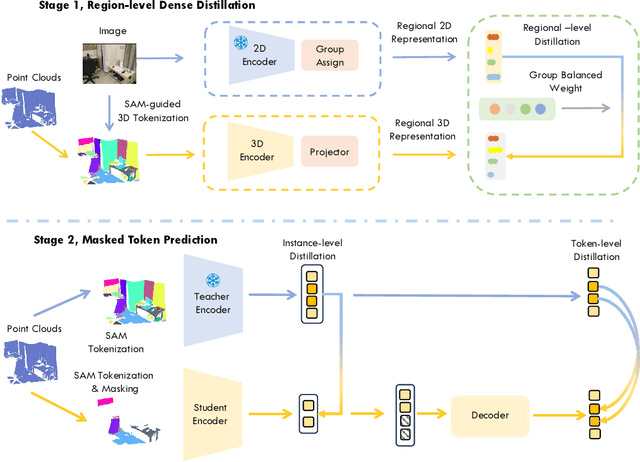

Abstract:Foundation models have significantly enhanced 2D task performance, and recent works like Bridge3D have successfully applied these models to improve 3D scene understanding through knowledge distillation, marking considerable advancements. Nonetheless, challenges such as the misalignment between 2D and 3D representations and the persistent long-tail distribution in 3D datasets still restrict the effectiveness of knowledge distillation from 2D to 3D using foundation models. To tackle these issues, we introduce a novel SAM-guided tokenization method that seamlessly aligns 3D transformer structures with region-level knowledge distillation, replacing the traditional KNN-based tokenization techniques. Additionally, we implement a group-balanced re-weighting strategy to effectively address the long-tail problem in knowledge distillation. Furthermore, inspired by the recent success of masked feature prediction, our framework incorporates a two-stage masked token prediction process in which the student model predicts both the global embeddings and the token-wise local embeddings derived from the teacher models trained in the first stage. Our methodology has been validated across multiple datasets, including SUN RGB-D, ScanNet, and S3DIS, for tasks like 3D object detection and semantic segmentation. The results demonstrate significant improvements over current State-of-the-art self-supervised methods, establishing new benchmarks in this field.
End-To-End Training and Testing Gamification Framework to Learn Human Highway Driving
Apr 18, 2024Abstract:The current autonomous stack is well modularized and consists of perception, decision making and control in a handcrafted framework. With the advances in artificial intelligence (AI) and computing resources, researchers have been pushing the development of end-to-end AI for autonomous driving, at least in problems of small searching space such as in highway scenarios, and more and more photorealistic simulation will be critical for efficient learning. In this research, we propose a novel game-based end-to-end learning and testing framework for autonomous vehicle highway driving, by learning from human driving skills. Firstly, we utilize the popular game Grand Theft Auto V (GTA V) to collect highway driving data with our proposed programmable labels. Then, an end-to-end architecture predicts the steering and throttle values that control the vehicle by the image of the game screen. The predicted control values are sent to the game via a virtual controller to keep the vehicle in lane and avoid collisions with other vehicles on the road. The proposed solution is validated in GTA V games, and the results demonstrate the effectiveness of this end-to-end gamification framework for learning human driving skills.
Point Cloud Self-supervised Learning via 3D to Multi-view Masked Autoencoder
Nov 17, 2023
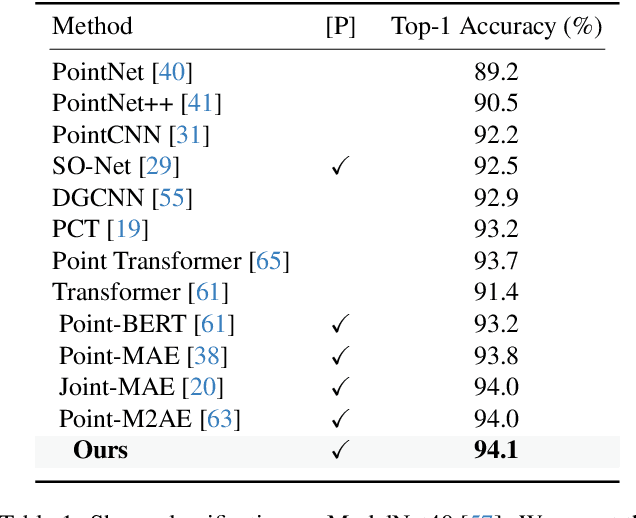

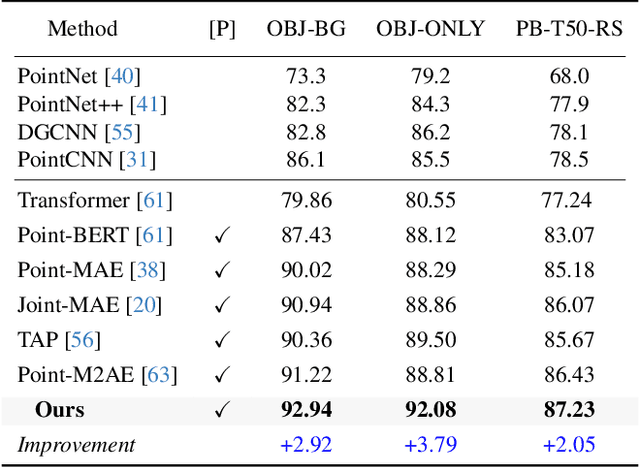
Abstract:In recent years, the field of 3D self-supervised learning has witnessed significant progress, resulting in the emergence of Multi-Modality Masked AutoEncoders (MAE) methods that leverage both 2D images and 3D point clouds for pre-training. However, a notable limitation of these approaches is that they do not fully utilize the multi-view attributes inherent in 3D point clouds, which is crucial for a deeper understanding of 3D structures. Building upon this insight, we introduce a novel approach employing a 3D to multi-view masked autoencoder to fully harness the multi-modal attributes of 3D point clouds. To be specific, our method uses the encoded tokens from 3D masked point clouds to generate original point clouds and multi-view depth images across various poses. This approach not only enriches the model's comprehension of geometric structures but also leverages the inherent multi-modal properties of point clouds. Our experiments illustrate the effectiveness of the proposed method for different tasks and under different settings. Remarkably, our method outperforms state-of-the-art counterparts by a large margin in a variety of downstream tasks, including 3D object classification, few-shot learning, part segmentation, and 3D object detection. Code will be available at: https://github.com/Zhimin-C/Multiview-MAE
EGraFFBench: Evaluation of Equivariant Graph Neural Network Force Fields for Atomistic Simulations
Oct 03, 2023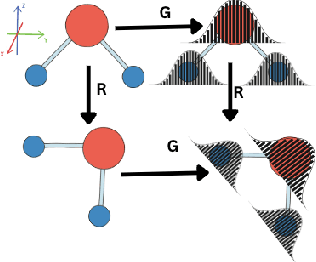



Abstract:Equivariant graph neural networks force fields (EGraFFs) have shown great promise in modelling complex interactions in atomic systems by exploiting the graphs' inherent symmetries. Recent works have led to a surge in the development of novel architectures that incorporate equivariance-based inductive biases alongside architectural innovations like graph transformers and message passing to model atomic interactions. However, thorough evaluations of these deploying EGraFFs for the downstream task of real-world atomistic simulations, is lacking. To this end, here we perform a systematic benchmarking of 6 EGraFF algorithms (NequIP, Allegro, BOTNet, MACE, Equiformer, TorchMDNet), with the aim of understanding their capabilities and limitations for realistic atomistic simulations. In addition to our thorough evaluation and analysis on eight existing datasets based on the benchmarking literature, we release two new benchmark datasets, propose four new metrics, and three new challenging tasks. The new datasets and tasks evaluate the performance of EGraFF to out-of-distribution data, in terms of different crystal structures, temperatures, and new molecules. Interestingly, evaluation of the EGraFF models based on dynamic simulations reveals that having a lower error on energy or force does not guarantee stable or reliable simulation or faithful replication of the atomic structures. Moreover, we find that no model clearly outperforms other models on all datasets and tasks. Importantly, we show that the performance of all the models on out-of-distribution datasets is unreliable, pointing to the need for the development of a foundation model for force fields that can be used in real-world simulations. In summary, this work establishes a rigorous framework for evaluating machine learning force fields in the context of atomic simulations and points to open research challenges within this domain.
DNN-DANM: A High-Accuracy Two-Dimensional DOA Estimation Method Using Practical RIS
Sep 25, 2023



Abstract:Reconfigurable intelligent surface (RIS) or intelligent reflecting surface (IRS) has been an attractive technology for future wireless communication and sensing systems. However, in the practical RIS, the mutual coupling effect among RIS elements, the reflection phase shift, and amplitude errors will degrade the RIS performance significantly. This paper investigates the two-dimensional direction-of-arrival (DOA) estimation problem in the scenario using a practical RIS. After formulating the system model with the mutual coupling effect and the reflection phase/amplitude errors of the RIS, a novel DNNDANM method is proposed for the DOA estimation by combining the deep neural network (DNN) and the decoupling atomic norm minimization (DANM). The DNN step reconstructs the received signal from the one with RIS impairments, and the DANM step exploits the signal sparsity in the two-dimensional spatial domain. Additionally, a semi-definite programming (SDP) method with low computational complexity is proposed to solve the atomic minimization problem. Finally, both simulation and prototype are carried out to show estimation performance, and the proposed method outperforms the existing methods in the two-dimensional DOA estimation with low complexity in the scenario with practical RIS.
* 11 pages, 12 figures
VEATIC: Video-based Emotion and Affect Tracking in Context Dataset
Sep 15, 2023



Abstract:Human affect recognition has been a significant topic in psychophysics and computer vision. However, the currently published datasets have many limitations. For example, most datasets contain frames that contain only information about facial expressions. Due to the limitations of previous datasets, it is very hard to either understand the mechanisms for affect recognition of humans or generalize well on common cases for computer vision models trained on those datasets. In this work, we introduce a brand new large dataset, the Video-based Emotion and Affect Tracking in Context Dataset (VEATIC), that can conquer the limitations of the previous datasets. VEATIC has 124 video clips from Hollywood movies, documentaries, and home videos with continuous valence and arousal ratings of each frame via real-time annotation. Along with the dataset, we propose a new computer vision task to infer the affect of the selected character via both context and character information in each video frame. Additionally, we propose a simple model to benchmark this new computer vision task. We also compare the performance of the pretrained model using our dataset with other similar datasets. Experiments show the competing results of our pretrained model via VEATIC, indicating the generalizability of VEATIC. Our dataset is available at https://veatic.github.io.
Bridging the Domain Gap: Self-Supervised 3D Scene Understanding with Foundation Models
May 16, 2023



Abstract:Foundation models have made significant strides in 2D and language tasks such as image segmentation, object detection, and visual-language understanding. Nevertheless, their potential to enhance 3D scene representation learning remains largely untapped due to the domain gap. In this paper, we propose an innovative methodology Bridge3D to address this gap, pre-training 3D models using features, semantic masks, and captions sourced from foundation models. Specifically, our approach utilizes semantic masks from these models to guide the masking and reconstruction process in the masked autoencoder. This strategy enables the network to concentrate more on foreground objects, thereby enhancing 3D representation learning. Additionally, we bridge the 3D-text gap at the scene level by harnessing image captioning foundation models. To further facilitate knowledge distillation from well-learned 2D and text representations to the 3D model, we introduce a novel method that employs foundation models to generate highly accurate object-level masks and semantic text information at the object level. Our approach notably outshines state-of-the-art methods in 3D object detection and semantic segmentation tasks. For instance, on the ScanNet dataset, our method surpasses the previous state-of-the-art method, PiMAE, by a significant margin of 5.3%.
Class-Level Confidence Based 3D Semi-Supervised Learning
Oct 18, 2022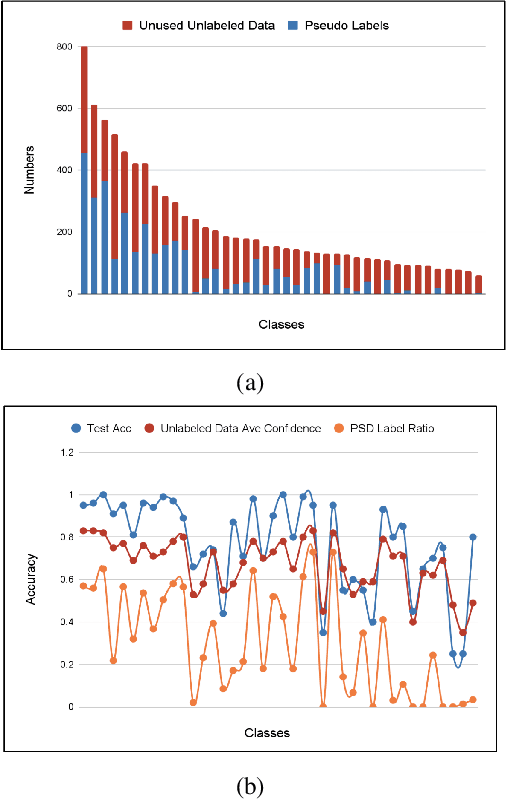

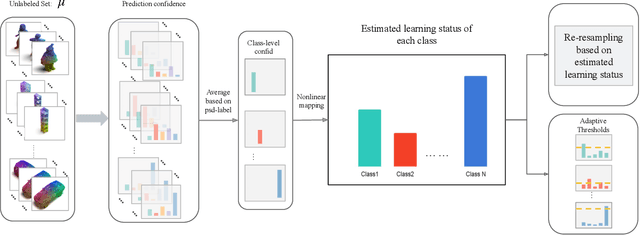

Abstract:Recent state-of-the-art method FlexMatch firstly demonstrated that correctly estimating learning status is crucial for semi-supervised learning (SSL). However, the estimation method proposed by FlexMatch does not take into account imbalanced data, which is the common case for 3D semi-supervised learning. To address this problem, we practically demonstrate that unlabeled data class-level confidence can represent the learning status in the 3D imbalanced dataset. Based on this finding, we present a novel class-level confidence based 3D SSL method. Firstly, a dynamic thresholding strategy is proposed to utilize more unlabeled data, especially for low learning status classes. Then, a re-sampling strategy is designed to avoid biasing toward high learning status classes, which dynamically changes the sampling probability of each class. To show the effectiveness of our method in 3D SSL tasks, we conduct extensive experiments on 3D SSL classification and detection tasks. Our method significantly outperforms state-of-the-art counterparts for both 3D SSL classification and detection tasks in all datasets.
A RIS-Based Passive DOA Estimation Method for Integrated Sensing and Communication System
Apr 25, 2022



Abstract:Integrated sensing and communication (ISAC) system has received growing attention, especially in the context of B5G/6G development. Combining the reconfigurable intelligent surface (RIS) with wireless communication process, a novel passive sensing technique is formulated in this paper to estimate the direction of arrival (DOA) of the targets, where the control matrix of the RIS is used to to realize the multiple measurements with only one full-functional receiving channel. Unlike the existing methods, the interference signals introduced by wireless communication are also considered. To improve the DOA estimation, a novel atomic norm-based method is proposed to remove the interference signals by the sparse reconstruction. The DOA is estimated after the interference removal by a novel Hankel-based multiple signal classification (MUSIC) method. Then, an optimization method is also developed for the measurement matrix to reduce the power interference signals and keep the measurement matrix's randomness, which guarantees the performance of the sparse reconstruction. Finally, we derive the theoretical Cram\'{e}r-Rao lower bound (CRLB) for the proposed system on the DOA estimation. Simulation results show that the proposed method outperforms the existing methods in the DOA estimation and shows the corresponding CRLB with different distributions of the sensing node. The code about the proposed method is available online https://github.com/chenpengseu/PassiveDOA-ISAC-RIS.git.
 Add to Chrome
Add to Chrome Add to Firefox
Add to Firefox Add to Edge
Add to Edge